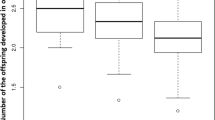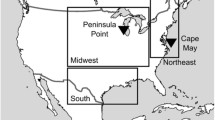Summary
The system formed byN. viridula and its almost specific parasitoidT. giacomellii has been studied in the Buenos Aires province, Argentina for 26 generations of the former and 20 generations of the latter. An intensive study over 9 host generations and key factor analysis made possible the identification and quantification of different mortality factors. The main factors determining the fluctuations in total generation mortality were: egg mortality due mainly to parasitism byT. basalis; nymphal predation on 1st, 2nd and 3rd instar nymphs and migration; and adult mortality and reduction on potential natality due to parasitism byT. giacomellii. Adult mortality and reduction of potential natality, due to parasitism byT. giacomellii, was density dependent. This factor is capable of maintaining the simulations generated by a simple model based on key factor analysis, within the range of observed densities. These results suggest that parasitism byT. giacomellii can regulate the population, even in a small area of 450 m2.
Similar content being viewed by others
References
Bailey VA, Nicholson AJ, Williams EJ (1962) Interaction between hosts and parasites when some host individuals are more difficult to find than others. J Theor Biol 3: 1–18
Bartlett MS (1949) Fitting a straight line when both variables are subject to error. Biometrics 5: 207–212
Beddington JR, Free CA, Lawton JH (1978) Modeling biological control: on the characteristics of successful natural enemies. Nature 273: 513–519
Bernstein C (1986) Density dependence and the stability of hostparasitoid system. Oikos 47: 176–180
Bernstein C (1987) On assessing the role of spatially-heterogeneous density-independent host mortality on the stability of host-parasitoids systems. Oikos 49: 236–239
Boer PJ den (1986) Density dependence and the stabilization of animal numbers. 1. The winter moth. Oecologia 69: 507–512
Boer PJ den (1988) Density dependence and the stabilization of animal numbers. The winter moth reconsidered. Oecologia 75: 161–168
Gaston KJ, Lawton JH (1987) A test of statistical techniques for detecting density dependence in sequential censuses of animal populations. Oecologia 74:404–410
Hassell MP (1984) Parasitism in patchy environments: inverse density dependence can be stabilizing. J Math App Med Biol 1: 123–133
Hassell MP (1986) Detecting density dependence. Trends Ecol Evol 1: 90–93
Hassell MP, May RM (1973) Stability in insect host-parasitoid models. J Anim Ecol 42:693–726
Hassell MP, May RM (1974) Aggregation of predators and insect parasites and its effect on stability. J Anim Ecol 43: 567–594
Hassell MP, Varley GC (1969) New inductive population model for insect parasites and its bearing on biological control. Nature 223: 1113–1137
Hassell MP, Lawton JH, May RM (1976) Patterns of dynamical behaviour in single species populations. J Anim Ecol 45:471–486
Hassell MP, Waage JK, May RM (1983) Variable parasitoid sex ratios and their effect on host-parasitoid dynamics. J Anim Ecol 52: 889–904
Hassell MP, Latto J, May RM (1989) Seeing the wood for the trees: detecting density dependence from existing life-table studies. J Anim Ecol 58: 883–892
Jolicoeur P (1968) Interval estimation of the slope of the major axis of a bivariate normal distribution in the case of a small sample. Biometrics 24: 679–682
Jolicoeur P, Mosimann JE (1968) Intervalles de confiance pour la pente de l'axe majeur d'une distribution normale bidimensionnelle. Biom Praxim 9: 122–140
Kiritani K (1964) Natural control of population of the southern green stink bug,Nezara viridula. Res Popul Ecol 6: 88–98
Kiritani K (1970) Studies on the adult polymorphism in the southern green stink bug,Nezara viridula (Hemiptera, Pentatomidae). Res Popul Ecol 12: 19–34
Kiritani K, Hokyo N (1962) Studies on the life table on the southern green stink bug,Nezara viridula. J Appl Ent Zool 6: 124–140
Latto J, Bernstein C (1990) Regulation in natural insect populations: reality or illusion?. Acta Oecologica-Oecologia Generalis (in press)
Latto J, Hassell MP (1987) Do pupal predators regulate the winter moth?. Oecologia 74: 153–155
Liljesthröm G (1980) Nota sobreTrichopoda giacomellii (Blanchard, 1966) (Diptera; Tachinidae). Neotropica 26: 233–236
Liljesthröm G (1981) Algunas consideraciones sobre la dinamica poblacional deNezara viridula (L.) (Hemiptera; Pentatomidae) e interacciones conTrichopoda giacomellii (Blanchard, 1966) (Diptera; Tachinidae). Neotropica 27: 11–16
Liljesthröm G (1983) Algunos aspectos de la demografia deNezara viridula (L.) (Hemiptera; Pentatomidae) en condiciones de laboratorio. Rev Soc Ent Argentina 42: 383–396
Liljesthröm G (1990) Revision de las especies de los generosTrichopoda Berthold yEutrichopodopsis Blanchard descriptas para la Republica Argentina. Rev Soc Ent Argentina (in press)
May RM (1978) Host-parasitoid systems in patchy environments: a phenomenological model. J Anim Ecol 47:833–843
Murdoch WW (1977) Stabilizing effects of spatial heterogeneity in predator-prey systems. Theor Pop Biol 11:252–273
Murdoch WW, Oaten A (1975) Predation and population stability. Adv Ecol Res 9:2–131
Murdoch WW, Reeve JD, Huffaker CB, Kennett CE (1984) Biological control of olive scale and its relevance to ecological theory. Am Nat 123:371–392
Murdoch WW, Chesson J, Chesson PL (1985) Biological control in theory and practice. Am Nat 125:344–366
Murdoch WW, Nisbet RM, Blythe SP, Gurney WSC, Reeve JD (1987) An invulnerable age class and stability in delay-differential parasitoid-host models. Am Nat 129:263–282
Podoler HG, Rogers D (1975) A new method for the identification of key factors from life table data. J Anim Ecol 44:85–114
Poethke HJ, Kirchberg M (1987) On stabilizing effect of density-dependent factors. Oecologia 74:156–158
Reeve JD, Murdoch WW (1985) Aggregation by parasitoids in successful control of the California red scale: a test of theory. J Anim Ecol 54:797–816
Slade NA (1977) Statistical detection of density dependence from a series of sequential censuses. Ecology 58:1094–1102
Sokal RR, Rohlf FG (1981) Biometry. W.H. Freeman & Co. New York
Stiling PD (1988) Density dependent processes and key factors in insect populations. J Anim Ecol 57:581–593
Sutherland WJ (1983) Aggregation and the “Ideal Free” distribution. J Anim Ecol 52:821–828
Varley GC, Gradwell GR (1960) Key factors in population studies. J Anim Ecol 29:399–401
Varley GC, Gradwell GR (1963) The interpretation of insect population changes. Proc Ceylon Assoc Adv Sci 18 (D):142–156
Varley GC, Gradwell GR (1968) Population models for the winter moth. In: Southwood TRE (Ed) Insect Abundance Symposium of the Royal Entomological Society of London 4, Blackwell Scientific Publications Oxford, pp 132–142
Vickery WL, Nudds TD (1984) Detection of density dependent effects in annual duck censuses. Ecology 65:96–104
Author information
Authors and Affiliations
Rights and permissions
About this article
Cite this article
Liljesthröm, G., Bernstein, C. Density dependence and regulation in the systemNezara viridula (L.) (Hemiptera: Pentatomidae), host andTrichopoda giacomellii (Blanchard) (Diptera: Tachinidae), parasitoid. Oecologia 84, 45–52 (1990). https://doi.org/10.1007/BF00665593
Received:
Accepted:
Issue Date:
DOI: https://doi.org/10.1007/BF00665593




